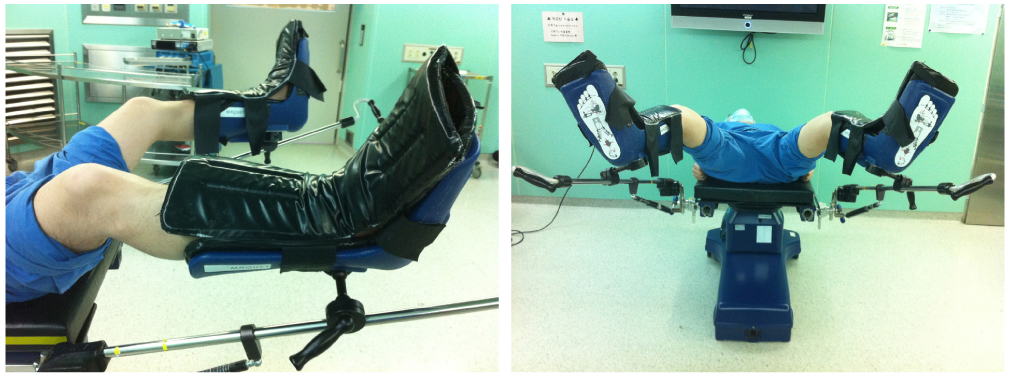Korean J Obstet Gynecol.
2012 Sep;55(9):687-691. 10.5468/KJOG.2012.55.9.687.
Five cases of neurologic complication in a boot support leg holder during laparoscopic surgery
- Affiliations
-
- 1Department of Obstetrics and Gynecology, Dongguk University Ilsan Hospital, Goyang, Korea. yoonprou@dumc.or.kr
- 2Department of Rehabilitation Medicine, Dongguk University Ilsan Hospital, Goyang, Korea.
- KMID: 2274145
- DOI: http://doi.org/10.5468/KJOG.2012.55.9.687
Abstract
- Lithotomy position has often been used in gynecologic surgeries. Nerve injury of lower extremities may be rare but can happen anytime during the surgeries. The pathogenesis of neurologic complications is not clear, but most of the neurologic complications are known to occur due to improper posture during surgery. Minor nerve injuries can recovered spontaneously, but severe injuries can cause slow recovery or permanent damage. The usage of generic knee support may cause compression to the nerves and increases the risk of hypoperfusion and difficulty in the change of posture during surgery, so in our hospital we have used a boot support leg holder during the surgery. Nevertheless, we experienced five cases of neurologic complication during a lithotomy position with usage of a boot support leg holder. Therefore we report these cases with review of literature.
Figure
Reference
-
1. Warner MA, Warner DO, Harper CM, Schroeder DR, Maxson PM. Lower extremity neuropathies associated with lithotomy positions. Anesthesiology. 2000. 93:938–942.2. Schaumburg HH, Berger AR, Thomas PK. Shaumburg HH, Berger AR, Thomas PK, editors. Acute and chronic focal nerve injury lesions. Disorders of peripheral nerves. 1992. Philadelphia (PA): FA Davis;209–253.3. Batres F, Barclay DL. Sciatic nerve injury during gynecologic procedures using the lithotomy position. Obstet Gynecol. 1983. 62:92s–94s.4. Corbu C, Campodonico F, Traverso P, Carmignani G. Femoral nerve palsy caused by a self-retaining polyretractor during major pelvic surgery. Urol Int. 2002. 68:66–68.5. Warner MA, Martin JT, Schroeder DR, Offord KP, Chute CG. Lower-extremity motor neuropathy associated with surgery performed on patients in a lithotomy position. Anesthesiology. 1994. 81:6–12.6. MacDonald PB, Strange G, Hodgkinson R, Dyck M. Injuries to the peroneal nerve in professional hockey. Clin J Sport Med. 2002. 12:39–40.7. Gousheh J, Babaei A. A new surgical technique for the treatment of high common peroneal nerve palsy. Plast Reconstr Surg. 2002. 109:994–998.8. Simms MS, Terry TR. Well leg compartment syndrome after pelvic and perineal surgery in the lithotomy position. Postgrad Med J. 2005. 81:534–536.9. Pfeffer SD, Halliwill JR, Warner MA. Effects of lithotomy position and external compression on lower leg muscle compartment pressure. Anesthesiology. 2001. 95:632–636.10. Kroll DA, Caplan RA, Posner K, Ward RJ, Cheney FW. Nerve injury associated with anesthesia. Anesthesiology. 1990. 73:202–207.11. Raza A, Byrne D, Townell N. Lower limb (well leg) compartment syndrome after urological pelvic surgery. J Urol. 2004. 171:5–11.12. Halliwill JR, Hewitt SA, Joyner MJ, Warner MA. Effect of various lithotomy positions on lower-extremity blood pressure. Anesthesiology. 1998. 89:1373–1376.13. Sinclair RH, Pratt JH. Femoral neuropathy after pelvic operation. Am J Obstet Gynecol. 1972. 112:404–407.14. Chan JK, Manetta A. Prevention of femoral nerve injuries in gynecologic surgery. Am J Obstet Gynecol. 2002. 186:1–7.15. Irvin W, Andersen W, Taylor P, Rice L. Minimizing the risk of neurologic injury in gynecologic surgery. Obstet Gynecol. 2004. 103:374–382.
- Full Text Links
- Actions
-
Cited
- CITED
-
- Close
- Share
- Similar articles
-
- Solo Three-incision Laparoscopic Cholecystectomy Using a Laparoscopic Scope Holder for Acute Cholecystitis
- Solo Intracorporeal Esophagojejunostomy Reconstruction Using a Laparoscopic Scope Holder in Single-Port Laparoscopic Total Gastrectomy for Early Gastric Cancer
- LiF TLD in TLD Holder for In Vivo Dosimetry
- Comparison of Short-term Outcomes of Laparoscopic-Assisted Colon Cancer Surgery Using a Joystick-Guided Endoscope Holder (Soloassist II) or a Human Assistant
- Reliability and Validity of Angle of Trunk Rotation Measurement Using Smartphone and 3D Printing Technology in Scoliosis


